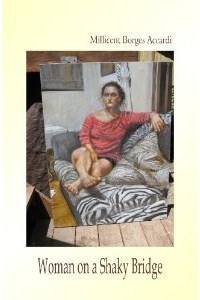Issue 4 - Winter 2011 Reviews Arranging the Blaze Beasts and Violins Crazy Jane Eating Fruit Out of Season Five Kingdoms Hard Rain Heathen Little Oceans Multiverse Open Slowly Psyche's Weathers Silent Music Something Must Happen The Apocalypse Tapestries The Darkened Temple The Kingdom of Possibilities The Tyranny of Milk This Pagan Heaven Woman on a Shaky Bridge You Know Who You Are Interviews
 |
Millicent Borges Accardi begins her collection, Woman on a Shaky Bridge, published by Finishing Line Press with a notation about a 1974 social experiment by Arthur Aron and Donald Dutton. In this experiment, an attractive woman interviewed men after they crossed a shaky bridge; she interviewed another group of men after they crossed a low solid bridge. More men phoned the woman after crossing the shaky bridge than those who crossed the solid bridge concluding, among other things:
Millicent Borges Accardi’s collection tackles the concept that anxiety or violence can be misattributed into attraction. But then goes one step further and shows us the interaction and the possible devastating outcome from this misplaced attribute. The collection does not disappoint in its attempt to explore a confusing and sometimes violent response to women under this concept. Accardi packs so much into Woman on a Shaky Bridge, a sixteen-poem collection, which will easily pull you into the many layers within each poem. Whether it is the nervousness of “Only more so” the hidden meanings of actions in “Coupling” or the interplay between brother and sister in “Buying Sleep (for mom)” her use of intriguing line breaks and enjambment create a voice that is halting, defiant and self-contained. This is the voice of a woman who sees things below the surface of seemingly harmless actions. Accardi manages this with beautifully defined language, even when the subject is disturbing, as in “Ciscenje Prostora (Ethnic Cleansing)”:
and then further on:
The reader is drawn into these scenes with hauntingly beautiful phrases that hold you in an unsettling juxtaposition of beauty and fear, anxiety and attraction.
This is a melodious portrait of a man who is consumed by what he does as much as who he is; as if he writhes through the music even as it writhes through him.
I had such a strong vision of this girl from this poem that I needed to see if I could find a copy of this picture on the Internet. I found an image in a collection of Jan Lukas photos. Unfortunately, this photo was not labeled. Even so, it appears that Accardi has captured the tension, awe, fear, and combined stillness of this girl within the lines of her poem. This collection holds such a variety of styles, voices, and images that I found myself moving from poem to poem completely absorbed in the depth, beauty, and elegance of her use of language. By the time you reach the end, it’s as if this collection explored more within its pages than sixteen poems could hold. The closing of “In Prague” sums the feeling I came away with after finishing this collection:
Reviewed by Joan Hanna. |
